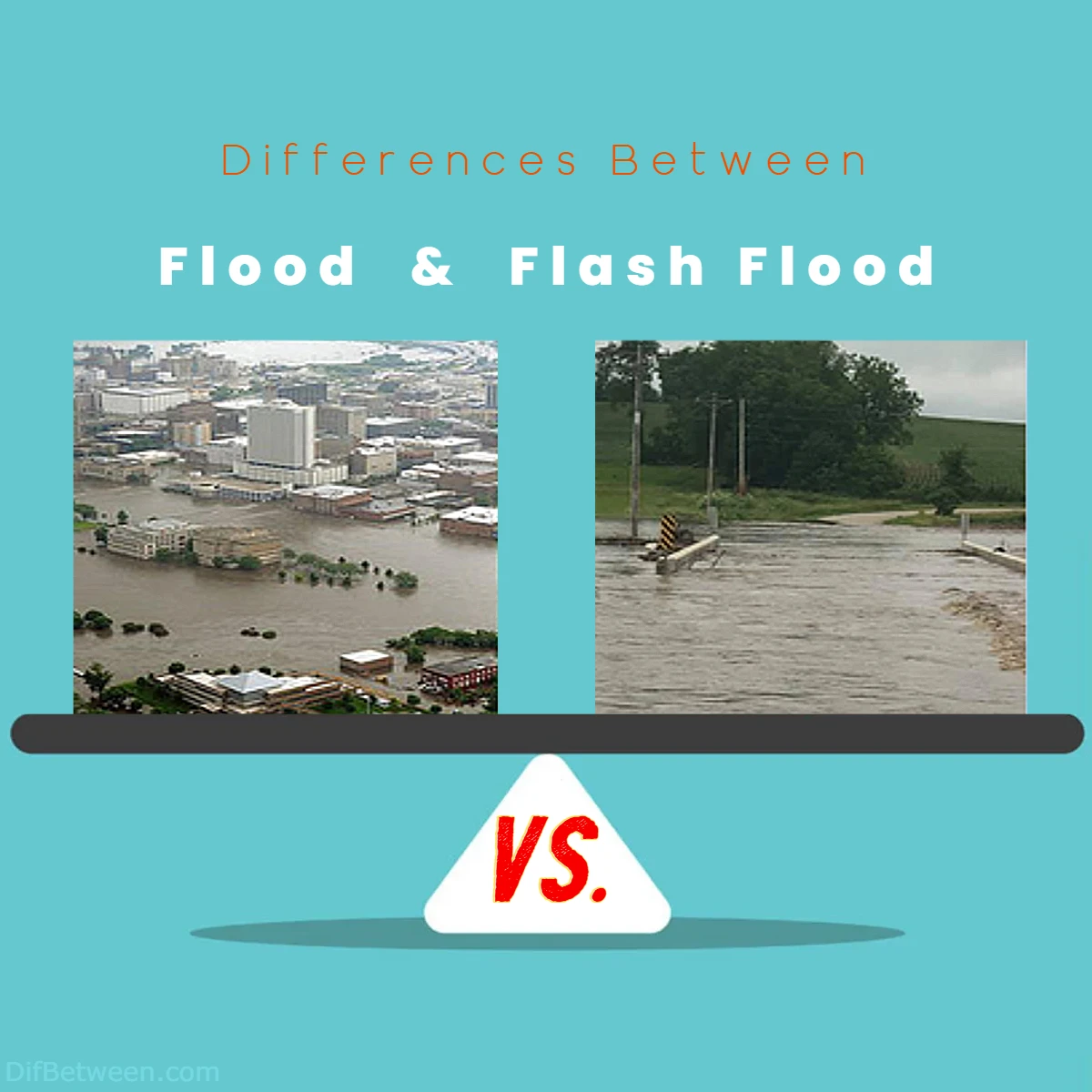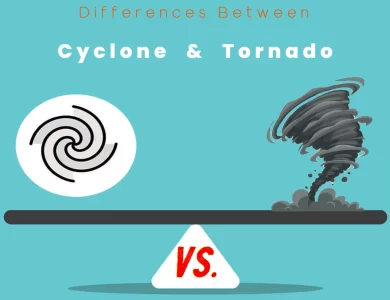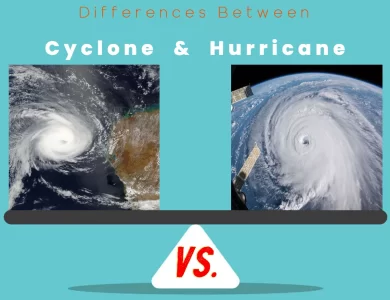
| Aspect | Floods | Flash Floods |
|---|---|---|
| Cause | Varied, including heavy rainfall, snowmelt, dam failures, and more. | Primarily intense rainfall, often from thunderstorms. |
| Onset | Gradual over hours to days. | Sudden, often within minutes to hours. |
| Predictability | Often predictable with advance warnings based on weather forecasts, river gauges, and historical data. | Less predictable due to rapid onset, with limited warning time. |
| Duration | Can last from days to weeks. | Typically brief, receding quickly after rain stops. |
| Impact Area | Extensive, affecting large areas, often entire regions. | Localized, affecting specific areas or communities. |
| Velocity of Water | Generally slower-moving water. | Swift and powerful water flow. |
| Warning Signs | Weather forecasts, river gauges, historical data, evacuation orders. | Intense rainfall, rising water levels, mudslides, emergency alerts. |
| Preparedness Time | Provides more time for preparation and response. | Requires immediate action with little time for preparation. |
| Economic Impact | Can result in substantial economic losses, affecting local economies. | Economic impact tends to be localized, affecting smaller areas. |
| Loss of Life | Can lead to fatalities, especially in densely populated areas with inadequate infrastructure. | Responsible for a significant proportion of flood-related fatalities. |
| Environmental Impact | Can harm ecosystems, disrupt wildlife habitats, and lead to soil erosion. | Can cause soil erosion, damage vegetation, and disrupt local ecosystems. |
| Displacement | May result in the temporary displacement of residents. | Displacement is often localized, affecting specific communities. |
Imagine a serene river slowly overflowing its banks after days of relentless rain—a flood in the making. Now, picture a sudden deluge of torrential rain, transforming a calm creek into a raging river within mere minutes—that’s a flash flood. The disparity between these two seemingly similar events is far more profound than you might think. From their causes to their consequences, from their predictability to their swiftness, we’ll unearth the key distinctions that make floods and flash floods unique in their own right.
Differences Between Flood and Flash Flood
The main differences between floods and flash floods lie in their onset and characteristics. Floods typically develop gradually over hours to days, often due to factors like heavy rainfall, river overflow, or dam failures, and they can affect large regions. In contrast, flash floods strike suddenly, within minutes to hours, primarily triggered by intense rainfall, often from thunderstorms, and their impact is localized, causing swift and powerful water flow. Understanding these distinctions is crucial for preparedness and staying safe during these natural disasters.
1. Introduction
What are Floods?
Floods are a natural disaster that occurs when water inundates areas that are typically dry. These events can be slow-developing or sudden, depending on the specific circumstances. Floods are typically caused by a variety of factors, including heavy rainfall, snowmelt, ice jams, dam failures, or the rapid melting of glaciers. The excess water accumulates in rivers, lakes, and other water bodies, causing them to overflow their banks and inundate surrounding areas.
Floods can vary significantly in scale and duration, ranging from localized and relatively minor events to large-scale catastrophes that affect entire regions. Their severity is often measured by factors such as water depth, flow rate, and the extent of inundation.
What are Flash Floods?
Flash floods, on the other hand, are a specific type of flood characterized by their sudden onset and rapid escalation. These events are among the most dangerous and unpredictable natural disasters. Unlike traditional floods, which can develop over days or weeks, flash floods can strike within minutes or hours of the triggering event.
Flash floods are typically the result of intense rainfall, often associated with thunderstorms, tropical storms, or hurricanes. The heavy rain quickly saturates the ground, causing streams and rivers to swell rapidly. The rapid accumulation of water can lead to devastating flooding in low-lying areas, canyons, and urban areas, posing a significant threat to life and property.
2. Causes
Flood Causes
Floods have a diverse range of causes, and they can be classified into several categories:
- Precipitation: Excessive rainfall or snowmelt can overload rivers and streams, leading to overflow.
- River Overflow: Rising water levels in rivers can result from upstream snowmelt, ice jams, or heavy rain.
- Dam or Levee Failures: The failure of dams or levees due to structural issues or overtopping can result in floods downstream.
- Storm Surges: Coastal areas can experience flooding due to storm surges during hurricanes or tropical storms.
- Glacial Lake Outbursts: The rapid release of water from glacial lakes, often caused by glacier retreat, can lead to flooding.
- Urbanization: Paved surfaces in urban areas prevent natural water absorption, increasing the risk of localized flooding during heavy rainfall.
Flash Flood Causes
Flash floods have distinct causes that set them apart from traditional floods:
- Intense Rainfall: The primary trigger for flash floods is exceptionally heavy rainfall, which can overwhelm drainage systems and natural watercourses.
- Thunderstorms: Flash floods are often associated with severe thunderstorms that produce torrential rain in a short period.
- Tropical Storms and Hurricanes: These weather systems can bring concentrated, heavy rain over a wide area, leading to flash flooding.
- Topography: Steep terrain, canyons, and narrow valleys can exacerbate flash flooding by channeling water quickly.
Now that we’ve explored the causes, let’s delve into the characteristics of floods and flash floods.
3. Characteristics
Flood Characteristics
Floods can be characterized by the following key features:
- Gradual Onset: Floods typically develop over hours, days, or even weeks, giving authorities and residents more time to prepare and respond.
- Predictability: Flooding events are often forecasted in advance based on weather patterns, river gauges, and historical data.
- Widespread Impact: Floods can cover extensive areas, affecting communities along riverbanks or in low-lying regions.
- Variable Duration: The duration of a flood can vary widely, from days to weeks, depending on the amount of rainfall and other contributing factors.
- Sediment Deposition: Floodwaters often carry sediment and debris, which can lead to long-term impacts on affected areas.
Flash Flood Characteristics
Flash floods are defined by their unique and distinct characteristics:
- Sudden Onset: Flash floods strike rapidly, often with little to no warning, making them extremely dangerous and difficult to prepare for.
- Unpredictable: These events can occur in areas that have experienced little or no rainfall, catching people off guard.
- Local Impact: Flash floods are typically localized, affecting specific areas or communities rather than entire regions.
- Brief Duration: Flash floods are intense but brief, with waters receding relatively quickly once the rain subsides.
- High Velocity: The swift and powerful flow of water during a flash flood can carry debris and pose a significant threat to life and property.
- Erosion: Flash floods can cause severe erosion in affected areas due to the rapid flow of water.
Now that we’ve explored their characteristics, let’s move on to the warning signs associated with floods and flash floods.
4. Warning Signs
Flood Warning Signs
Floods often come with several warning signs that allow for some preparation and evacuation, including:
- Weather Forecast: Meteorologists can predict heavy rainfall events that may lead to flooding in advance.
- River Gauges: Monitoring of river and stream levels can provide early warnings of rising water.
- Evacuation Orders: Local authorities may issue evacuation orders based on flood forecasts.
- Historical Data: Past flood events can serve as indicators of potential future floods in specific areas.
- Flood Watches and Warnings: The National Weather Service issues flood watches and warnings to inform the public of potential or ongoing flooding.
Flash Flood Warning Signs
Flash floods, in contrast, can catch people by surprise due to their rapid onset, but there are still some signs to watch for:
- Intense Rainfall: Heavy rainfall, especially during a thunderstorm, can be a precursor to flash flooding.
- Rising Water: Rapidly rising water levels in creeks, streams, or rivers are an immediate sign of potential flash flooding.
- Mudslides: In areas with recent wildfires or in regions with loose soil, mudslides can occur during heavy rain, causing flash floods.
- Emergency Alerts: Local authorities and the National Weather Service may issue flash flood warnings through various communication channels.
- Flash Flood Watch: A watch indicates that flash flooding is possible in the near future, even if it hasn’t started yet.
Understanding these warning signs is crucial for staying safe during flood and flash flood events. Now, let’s explore the impacts of these natural disasters.
5. Impacts
Flood Impacts
Floods can have wide-ranging and long-lasting impacts on communities and the environment:
- Property Damage: Floodwaters can inundate homes, businesses, and infrastructure, causing extensive damage.
- Displacement: Flooding often leads to the temporary displacement of residents who must evacuate to safer areas.
- Economic Losses: The cost of flood damage can be substantial, affecting local economies and requiring extensive recovery efforts.
- Health Risks: Floodwaters can pose health risks due to contamination and the spread of waterborne diseases.
- Environmental Impact: Floods can harm ecosystems, disrupt wildlife habitats, and lead to soil erosion.
Flash Flood Impacts
Flash floods are known for their immediate and severe impacts:
- Swift Destruction: Flash floods can sweep away vehicles, buildings, and people with little warning.
- Loss of Life: Flash floods are responsible for a significant number of flood-related fatalities.
- Limited Response Time: The rapid onset of flash floods leaves little time for evacuation or emergency response.
- Property Damage: Homes and infrastructure in the path of a flash flood are at risk of severe damage or destruction.
- Environmental Impact: Flash floods can erode soil, damage vegetation, and disrupt local ecosystems.
- Community Disruption: Flash floods can disrupt communities and infrastructure, leading to power outages and road closures.
6. Prevention and Preparedness
Flood Preparedness
Preventing floods is challenging, but preparedness measures can help mitigate their impact:
- Flood Insurance: Purchase flood insurance to protect your property and belongings.
- Elevation: If you live in a flood-prone area, consider elevating your home or business.
- Flood Barriers: Invest in flood barriers or sandbags to protect against rising waters.
- Emergency Kit: Prepare an emergency kit with essential supplies and keep it readily accessible.
- Evacuation Plan: Develop and practice an evacuation plan with your family.
- Stay Informed: Monitor weather forecasts, river gauges, and official alerts.
Flash Flood Preparedness
Due to their sudden nature, flash floods require specific preparedness steps:
- Immediate Action: If you receive a flash flood warning, take it seriously and act quickly.
- Evacuation: Evacuate low-lying areas and move to higher ground as soon as possible.
- Avoid Flooded Roads: Never attempt to drive or walk through flooded roads or waterways.
- Emergency Kit: Have an emergency kit ready with essentials like food, water, and first-aid supplies.
- Communication: Ensure you have a way to receive emergency alerts and communicate with family members.
- Stay Alert: Stay informed about weather conditions, especially during thunderstorms.
7. Additional Information and Statistics
Let’s dive deeper into some additional information and statistics regarding floods and flash floods to enhance your understanding of these natural disasters.
Flood Statistics
Floods have been a recurring threat throughout history, affecting various regions around the world. Here are some key statistics related to floods:
- Global Impact: Floods are among the most common and widespread natural disasters globally, causing extensive damage to both developed and developing countries.
- Economic Cost: Floods can result in substantial economic losses. For instance, the United States has experienced billions of dollars in flood-related damages in recent years.
- Human Toll: Floods can lead to the loss of human lives. Flooding events often result in fatalities, especially in densely populated areas with inadequate infrastructure.
- Flood Duration: The duration of a flood can vary widely. While some floods may recede relatively quickly, others can persist for weeks or even months, causing prolonged disruptions.
Flash Flood Statistics
Flash floods, characterized by their rapid onset and intensity, pose a unique set of challenges. Let’s look at some specific statistics related to flash floods:
- Deadly Nature: Flash floods are responsible for a significant proportion of flood-related fatalities. In some regions, they account for the majority of flood-related deaths.
- Limited Warning Time: The sudden nature of flash floods means that warning times can be extremely short, often just minutes or hours. This limited warning time makes preparedness critical.
- Geographical Distribution: Flash floods are not limited to any specific geographical area. They can occur in a wide range of settings, from mountainous regions to urban areas.
Conclusion
Floods and flash floods are both water-related disasters, but their differences in causes, characteristics, warning signs, and impacts make them unique challenges to tackle. Understanding these distinctions and being prepared for both scenarios can significantly increase your chances of staying safe during these events.
Remember that preparedness, early warning systems, and community resilience are key factors in minimizing the negative impacts of floods and flash floods. Stay informed, have a plan in place, and be ready to take swift action when needed to protect yourself and your loved ones from the dangers posed by these natural disasters.
FAQs
The primary difference lies in their onset and characteristics. Floods develop gradually over hours to days, often due to factors like heavy rainfall, river overflow, or dam failures, affecting large regions. In contrast, flash floods occur suddenly, within minutes to hours, primarily triggered by intense rainfall, often from thunderstorms, and they impact specific areas with swift and powerful water flow.
Flash floods are typically more dangerous due to their rapid onset and intensity. They can sweep away vehicles, buildings, and people with little warning, making them extremely perilous. While floods can also be dangerous, they often provide more time for preparation and evacuation.
Yes, flash floods can occur in a wide range of settings, from mountainous regions to urban areas. Their occurrence is primarily linked to intense rainfall events, making them a potential threat in various locations.
Staying informed through weather forecasts, river gauges, and emergency alerts is crucial. For floods, you often have more time to prepare and evacuate if needed. In the case of flash floods, immediate action, such as moving to higher ground, is essential.
Flash floods are responsible for a significant proportion of flood-related fatalities, mainly due to their sudden and powerful nature. However, the overall impact depends on various factors, including the specific circumstances and the preparedness of the affected community.
While flash floods are localized and typically affect smaller areas, they can cause severe damage to homes, infrastructure, and the environment within their path. Floods, on the other hand, often impact larger regions and can result in extensive economic losses.
Yes, floods are often predictable with advance warnings based on weather forecasts, river gauges, and historical data. Flash floods, however, are less predictable due to their rapid onset, and warnings may come with very limited lead time, often minutes to hours.
Both floods and flash floods involve the inundation of areas by water, and they can both result in property damage, displacement of residents, economic losses, and environmental impacts. However, their distinct characteristics and causes set them apart.
Read More:
Contents






